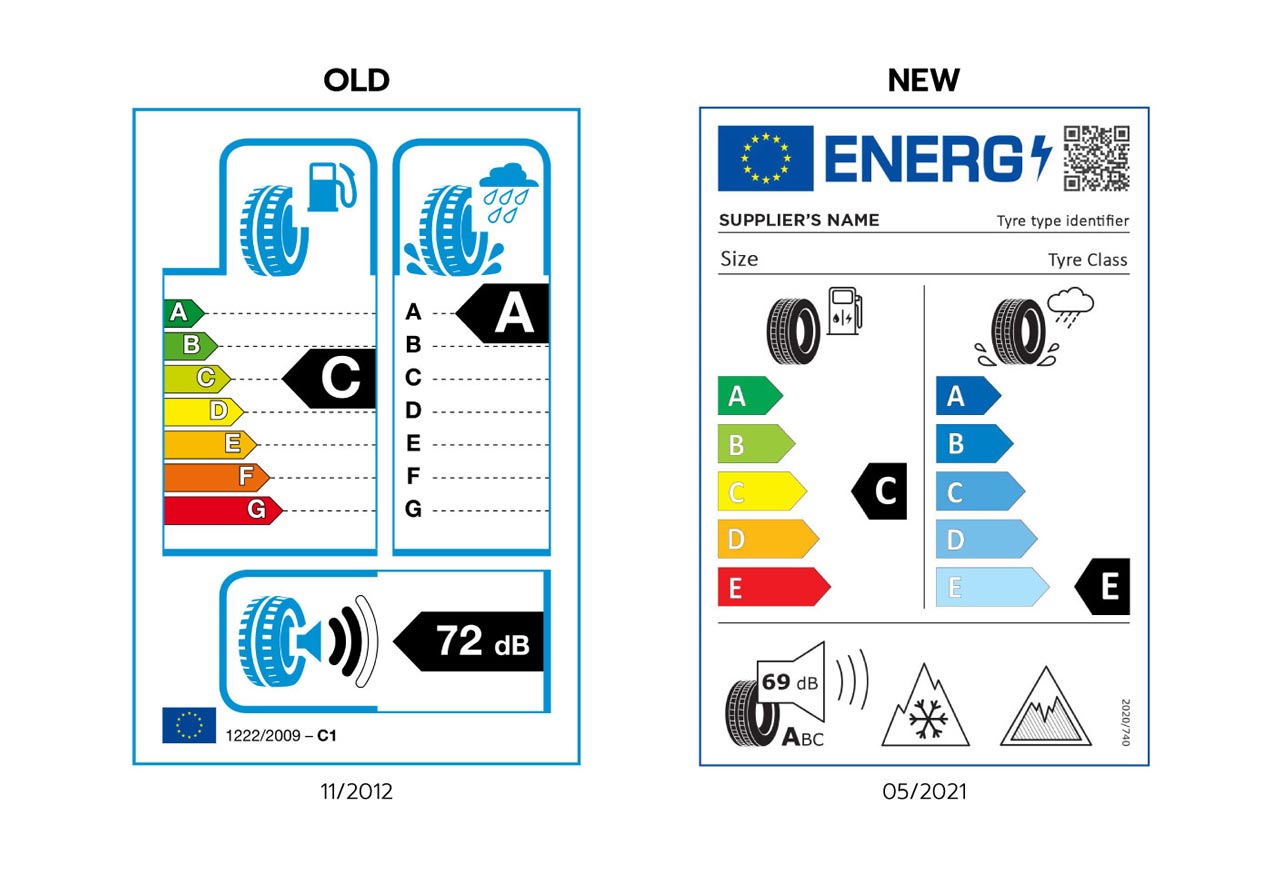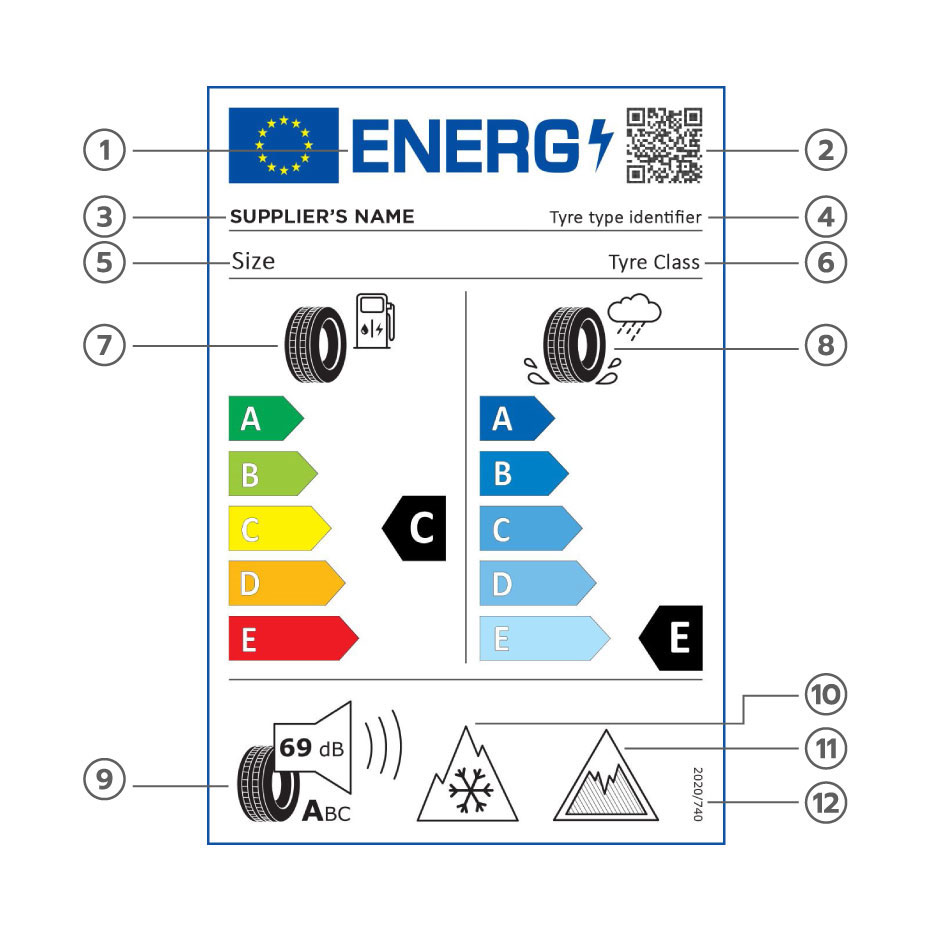NEW EU TYRE LABELLING
As the EU heads towards its goal of becoming CO2 neutral by 2050 it is trying to cut emissions across various sectors including the transport sector. The new EU tyre labelling regulation aims to help achieve this goal by reducing CO2 levels as it provides the consumers information to identify and purchase more fuel efficient tyres.
The new EU labelling Regulation (EU) 2020/740 comes into effect from 1st May 2021 and replaces the previous Regulation (EC) No 1222/2009, which has been in effect from 2012. This labelling scheme allows consumers to make an informed purchase decision on the various performance paraments of the tyres such as rolling resistance which translates into fuel efficiency, wet grip and noise. Additionally, the new labelling also introduces pictograms that indicate if the tyre is suitable for use in severe snow conditions(3PMSF) and its grip in icy conditions (the later applies to C1 tyres only).
For additional information please visit the official European Commission website.

The New EU Tyre Label
- The new regulation covers C1(Car & SUV), C2(Van & Light Trucks) and C3(Bus & Truck) tyres
- A tyre type identification number has been added to the label
- A unique QR code for each article has been added that links the to the EPREL (European Product Registry for Energy Labelling)
- Noise Classes A, B and C replace the previous sound waves
- There are options for including pictograms for severe snow conditions (3PMSF) 3 Peak Mountain Snowflake or Alpine symbol. C1 Tyres suitable for ice conditions(Friction) can also be represented with an ice grip pictogram.
- Rolling Resistance label classes have been reclassified – The earlier E class has now been moved to D class, F & G class have now been grouped under E class.
- Wet Grip labels classes have been reclassified - The earlier E class has now been moved to D class, and the earlier F class has now been made E class.
How to read the New EU tyre label

The tyre label features different fields and pictograms.
- Energy Label – This is the new label title.
- QR Code – This links to the EPREL database. Consumers can scan this and get all the EU label information in a tabular form.
- Supplier name - Trade Name or Trade Mark of the supplier
- Tyre type identifier – This is a unique article number that identifies the product
- Tyre Size – this shows the tyre size designation, load-capacity index and speed category symbol
- Tyre Class – This identifies the class of the tyre i.e. C1(Car & SUV), C2(Van & Light Truck) or C3(Truck and Bus).
- Fuel Efficiency pictogram – depending on the tyre’s rolling resistance its fuel efficiency is graded from A all the way down to E. With A denoting the best fuel efficiency.
- Wet Grip pictogram – This pictogram shows how well the tyre will perform in wet conditions. With performance graded from A down to E, with A signifying the shortest braking distance on wet roads.
- External rolling noise pictogram – This measures the noise levels in dB(decibels), followed by a noise class which replaces the existing sound bars. The noise class is graded from A down to C.
- Snow grip pictogram (3PMSF) – This pictogram is mainly shown on winter and all weather tyres. It shows that the tyre is suited for performance in severe snow conditions. This is also known as the 3PMSF (3 Peak Mountain Snow Flake) or the Alpine Symbol.
- Ice grip pictogram – This is shown on winter tires that have outstanding ice performance which has been confirmed by a defined ice grip test. These tyres are designed for extremely severe climate conditions such as those in the Nordics where roads are covered with ice or hard compact snow. Such tyres should not be used in less severe climate conditions.
- Regulation Serial number – This regulation’s serial number is: 2020/740
This Regulation does not apply to:
- Tyres classified as POR or Professional Off‐road tyres.
- Tyres designed to be fitted only on vehicles registered for the first time before 1 October 1990.
- Tyres designed as “Temporary use spare tyres” and marked “Temporary use only”.
- Tyres whose speed rating is less than 80 km/h.
- Tyres whose nominal rim diameter does not exceed 10” (or ≤ 254 mm) or is more than 25” (or ≥ 635 mm).
- Tyres designed to be fitted/fitted with additional devices to improve traction properties, such as studdable/studded tyres.
- Tyres designed only to be fitted on vehicles intended exclusively for racing.
- Second‐hand tyres, unless such tyres are imported from a third country.
